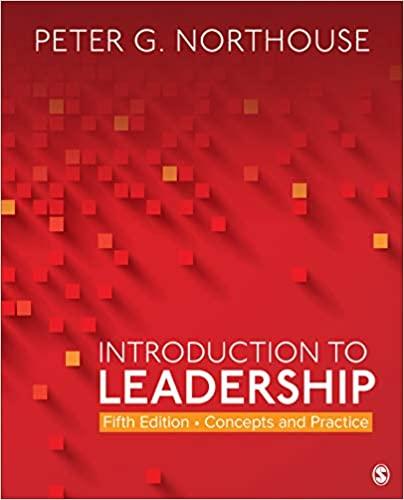For most companies in todays business world, profits (also referred to as the bottom line) are the
Question:
For most companies in today’s business world, profits (also referred to as “the bottom line”) are the standard measurement of success. But the past decade has seen a dramatic rise in a different model: socially minded companies, which are for-profit companies formed with strong missions not just to make money but to be a force for good within their own operations, in their communities, and globally.
Believing their missions are as important as, if not more important than, their bottom lines has led companies to develop and adopt a more comprehensive approach for defining corporate success. And a handful of states, like Vermont, are supporting and fostering this new way of doing business.
This new approach of measuring corporate success by more than just a myopic view of profits was spearheaded in 1994 with the development of an accounting framework known as the Triple Bottom Line (TBL or 3BL). In addition to considering financial profitability, the TBL includes measures of a company’s commitment to corporate social responsibility through its social (people) and environmental (planet) impacts.
In addition to a new accounting system, a new corporate entity known as a Benefit Corporation, commonly referred to as a B Corporation or B Corp, was created for these new socially minded enterprises. The B Corporation is a legal structure for a business, like a limited liability company or a corporation. B Corporations are legally empowered to pursue positive stakeholder impact alongside profit. The B Corp structure requires companies’ board of directors to consider other public benefits in addition to profit and also prevents shareholders from using stock value declines as a reason for seeking management dismissal or to pursue lawsuits against the corporation. Transparency is also built into the structure, requiring B Corps to “publish annual benefit reports of their social and environmental performance using a comprehensive, credible, independent, and transparent third-party standard”
(Gifted for Good, 2019). Key drivers behind the emergence of B Corporations are the increasing efforts of more conventional profit-driven companies to be seen as “green” and “good” as well as to “redefine the way people perceive success in the business world” (Kim, Karlesky, Myers, & Schifeling, 2016, para.
11).
To see how B Corp entities are effecting the corporate and community landscape, consider the state of Vermont. In 2010, believing that companies focused on being a force for good increased the livability of their communities and are essential to a healthy state economy, Vermont became the second U.S. state to enact Benefit Corporation legislation. By 2019, Vermont boasted the highest number of B Corps per capita with more than 30 scattered throughout the state (State of Vermont, 2019).
Vermont-based companies have a long history of ethically and socially aware business endeavors, beginning with beloved ice cream giant, Ben & Jerry’s. When the founders created the company in 1978 in an old gas station in Burlington, they made it clear they “didn’t want to make a profit by taking advantage of someone” (Fee, 2018, para. 6). They committed to ensuring their ice cream business gave back to the community with a written mission statement declaring Ben & Jerry’s intent to balance the company’s social and economic missions. It made good on that promise, donating 7.5% of its pretax profits to charity. The company also sourced its ingredients from other small local businesses. Over the years, Ben & Jerry’s social and environmental missions have continued to expand both internally and externally, encompassing workers’ rights, anti-racism, refugee asylum, global marriage equality and LGBT rights, and air quality and clean air, as well as climate issues (Ben & Jerry’s, n.d.)..............
Questions
1. Discuss how the Triple Bottom Line and B Corporation concepts relate to each of the Six Pillars of Character that influence ethical leadership:
a. Trustworthiness
b. Respect
c. Responsibility
d. Fairness
e. Caring
f. Citizenship
2. Ethical leaders as discussed in the chapter use “moral means to achieve their goals.” Discuss how this definition would apply to companies desiring to be B Corporations.
3. Transparency in B Corporations is a key element to their status and certification. How does this transparency relate to the chapter’s discussion on honesty and the balance required to appropriately disclose information?
4. The chapter outlines three leadership values used to distinguish ethical leaders: ethical, modal, and end.
a. Describe how each of these values might be reflected in a B Corporation.
b. Describe how each of these values is reflected in Vermont’s encouragement of B Corporations in the state.
5. The text defines ethical leadership as “the influence of a moral person who moves others to do the right thing in the right way for the right reasons.” Do you think, after reading that this definition applies only to “persons,” or can it be expanded to entities such as companies, states, and other government entities? Why or why not?
Step by Step Answer:

Introduction To Leadership Concepts And Practice
ISBN: 9781544351599
5th Edition
Authors: Peter G Northouse





